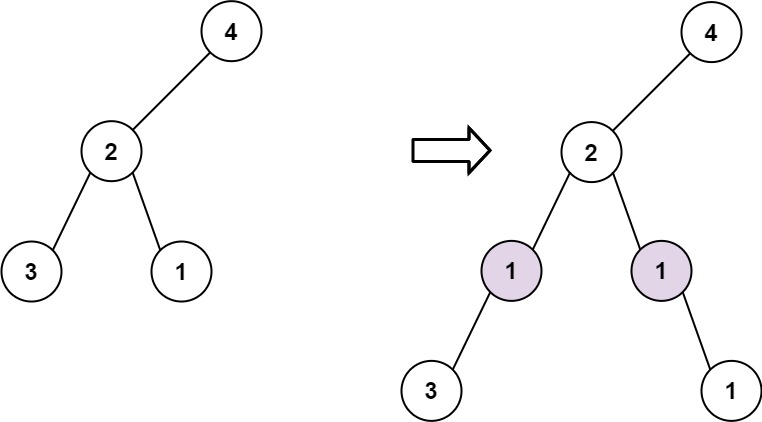Understand what the interviewer is asking for by using test cases and questions about the problem.
- Established a set (2-3) of test cases to verify their own solution later.
- Established a set (1-2) of edge cases to verify their solution handles complexities.
- Have fully understood the problem and have no clarifying questions.
- Have you verified any Time/Space Constraints for this problem?
O(n) and space O(N)
HAPPY CASE
Input: root = [4,2,6,3,1,5], val = 1, depth = 2
Output: [4,1,1,2,null,null,6,3,1,5]
Input: root = [4,2,null,3,1], val = 1, depth = 3
Output: [4,2,null,1,1,3,null,null,1]
EDGE CASE
Input: root = [1], val=1, depth=1
Output: [1,1,null]Match what this problem looks like to known categories of problems, e.g. Linked List or Dynamic Programming, and strategies or patterns in those categories.
If you are dealing with Binary Trees some common techniques you can employ to help you solve the problem:
Plan the solution with appropriate visualizations and pseudocode.
Approach #1 DFS:
General Idea: Recursively decrement the height until the desired depth and add the new node and attach the previous node to left or right branch as appropriate.
1. Handle edgecase root is none
2. Handle edgecase depth is 1:
3. Handle edgecase depth is 2: Add new node and attach root.left or root.right
4. Continue to reduce depth and recursively call
4. Return the rootApproach #2 BFS:
General Idea: Level order traversal and decrement the height until the desired depth and add the new node and attach the previous node to left or right branch as appropriate.
1. Handle edgecase depth is 1: Add new node and attach root.
2. Create queue and iterate until desired depth
3. Attach new node to all items in queue
4. Return the root⚠️ Common Mistakes
Implement the code to solve the algorithm.
Approach #1 DFS:
class Solution:
def addOneRow(self, root: Optional[TreeNode], val: int, depth: int) -> Optional[TreeNode]:
# Handle edgecase root is none
if not root:
return None
# Handle edgecase depth is 1: Add new node and attach root.
elif depth == 1:
return TreeNode(val, root)
# Handle edgecase depth is 2: Add new node and attach root.left or root.right
elif depth == 2:
root.left = TreeNode(val, root.left, None)
root.right = TreeNode(val, None, root.right)
# Continue to reduce depth and recursively call
else:
self.addOneRow(root.left, val, depth-1)
self.addOneRow(root.right, val, depth-1)
# Return root
return rootclass Solution {
public TreeNode addOneRow(TreeNode root, int v, int d) {
// Handle edgecase root is none
if(root == null) return null;
// Handle edgecase depth is 1: Add new node and attach root.
if(d == 1) return new TreeNode(v, root, null);
// Handle edgecase depth is 2: Add new node and attach root.left or root.right
if(d == 2){
root.left = new TreeNode(v, root.left, null);
root.right = new TreeNode(v, null, root.right);
// Continue to reduce depth and recursively call
} else{
addOneRow(root.left, v, d-1);
addOneRow(root.right, v, d-1);
}
// Return root
return root;
}
}Approach #2 BFS:
# Definition for a binary tree node.
# class TreeNode:
# def __init__(self, val=0, left=None, right=None):
# self.val = val
# self.left = left
# self.right = right
class Solution:
def addOneRow(self, root: Optional[TreeNode], val: int, depth: int) -> Optional[TreeNode]:
# Handle edgecase depth is 1: Add new node and attach root.
if depth == 1:
return TreeNode(val, root)
# Create queue and iterate until desired depth
queue = [root]
while depth > 2:
for _ in range(len(queue)):
node = queue.pop(0)
if node.left:
queue.append(node.left)
if node.right:
queue.append(node.right)
depth -= 1
# Attach new node to all items in queue
while queue:
node = queue.pop(0)
node.left = TreeNode(val, left = node.left)
node.right = TreeNode(val, right = node.right)
# Return the root
return rootclass Solution {
public TreeNode addOneRow(TreeNode root, int val, int depth) {
// Handle edgecase depth is 1: Add new node and attach root.
if (depth == 1) {
return new TreeNode(val,root,null);
}
// Create queue and iterate until desired depth
Queue<TreeNode> q = new LinkedList<>();
q.add(root);
int currDepth = 2;
while(currDepth++ < depth) {
int width = q.size();
while(width-- > 0) {
TreeNode curr = q.poll();
if(curr.left != null)
q.add(curr.left);
if(curr.right != null)
q.add(curr.right);
}
}
// Attach new node to all items in queue
for(TreeNode node : q) {
node.left = new TreeNode(val,node.left,null);
node.right = new TreeNode(val,null,node.right);
}
// Return the root
return root;
}
}Review the code by running specific example(s) and recording values (watchlist) of your code's variables along the way.
Evaluate the performance of your algorithm and state any strong/weak or future potential work.
Assume N represents the number of nodes in binary tree
Approach #1 DFS & #2 BFS Share the same time and space complexity:
O(N) because we may need to visit each node in the binary treeO(N) because we used BFS requires O(N/2 + 1). The maximum number of leaf nodes in a perfect binary tree is N/2 and the given the previous node already in the queue. As for DFS we need O(N) to account for unbalanced tree (space is used for the recursion stack). In the general case O(logN) for balanced tree.